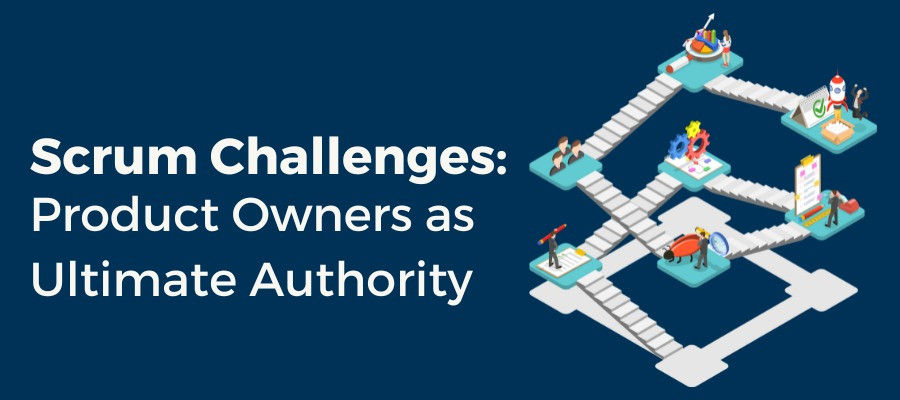How does Scrum encounter challenges when Product Owners assume the role of the ultimate authority

Scrum, an Agile development methodology, relies on collaboration, transparency, and shared decision-making to drive successful product development. Central to the Scrum process is the role of the Product Owner, who plays a crucial part in bringing the product vision to life. The Product Owner liaises between stakeholders and the development team, ensuring that the product meets customer needs and aligns with business goals.
However, challenges can arise when Product Owners assume the role of the ultimate authority within the Scrum framework. This article explores the implications of such a scenario and its potential obstacles to the Scrum methodology. By examining the consequences of an authoritative Product Owner, we can gain insights into how Scrum encounters challenges and explore strategies to overcome them effectively.
The Role of the Product Owner in Scrum
The role of the Product Owner in Scrum is critical to the success of the development process. As a key stakeholder, the Product Owner deeply understands users, the market, competitors, and industry trends. Their primary responsibility is maximizing the product's value from the development team's efforts.
According to the Scrum Guide, how the Product Owner achieves this goal may vary depending on the organization, Scrum teams, and individual preferences. However, a common aspect of their role is managing the product backlog. The product backlog is a prioritized list of features and requirements that guide the development team's work.
During the sprint planning meeting, the Product Owner collaborates with the development team to prioritize the backlog items based on value, user needs, and business objectives.
Challenges when Product Owners assume the role of the ultimate authority
While the role of a product owner carries significant responsibilities, it is crucial to avoid assuming the part of the ultimate authority. Product owners who adopt an authoritarian approach may encounter challenges that hinder successful product development. Some of these challenges include:
Lack of input and collaboration: Assuming ultimate authority can stifle collaboration and limit the information and expertise of other team members. It must consider the valuable insights and perspectives of developers, designers, and stakeholders, leading to missed opportunities and suboptimal solutions.
Reduced ownership and accountability: Product owners may inadvertently discourage team members from taking ownership of their work by exerting ultimate authority. When individuals feel their contributions are not valued, or their ideas are disregarded, it can lead to a decline in motivation and accountability.
Limited innovation and creativity: Creativity and innovation thrive in environments that encourage diverse thinking and perspectives. When a product owner assumes ultimate authority, it can suppress the creativity and innovative ideas that emerge from the team's collective wisdom. This hampers the potential for groundbreaking solutions and limits the product's competitive advantage.
Decreased morale and engagement: Autocratic decision-making can reduce morale and engagement among team members. When individuals feel disempowered or excluded from decision-making, their enthusiasm and commitment to the project can erode. This can have a detrimental effect on productivity and the overall success of the product.
Risk of blind spots and tunnel vision: No single person can possess all the knowledge and expertise required for successful product development. Assuming ultimate authority can lead to blind spots and tunnel vision, as the product owner may overlook critical aspects or fail to consider alternative perspectives. This increases the risk of making flawed decisions or missing essential opportunities.
To address these challenges, product owners should adopt a collaborative and inclusive approach that values the input and expertise of the entire team. This involves:
Fostering a culture of open communication and active listening, encouraging team members to share their ideas and concerns.
Solutions and strategies to address these challenges
- Embracing a servant-leadership mindset, where the product owner supports and empowers the team rather than dictating every decision.
- Seeking consensus and input from stakeholders and team members to ensure a more well-rounded and informed decision-making process.
- Creating an environment that promotes continuous learning, experimentation, and adaptation allows innovation and creative problem-solving.
- Recognizing and appreciating the contributions of individual team members reinforces a sense of ownership and accountability.
Product owners can overcome the challenges of assuming ultimate authority by shifting away from an authoritarian approach and embracing a collaborative mindset. This leads to more effective product development, robust team dynamics, and tremendous success in delivering valuable customer solutions.
Conclusion
When Product Owners assume the role of the ultimate authority within the Scrum framework, it can introduce significant challenges to the development process. The authoritarian approach can hinder collaboration, limit input and innovation, reduce ownership and accountability, decrease morale and engagement, and create blind spots in decision-making.
However, by adopting a collaborative and inclusive approach, product owners can mitigate these challenges and unlock the full potential of the Scrum methodology. To address these challenges, product owners should foster open communication, encourage diverse perspectives, and embrace a servant-leadership mindset.
Reference
- https://www.lucidchart.com/blog/7-biggest-pain-points-for-product-owners
- https://business.adobe.com/blog/basics/product-owner#:~:text=The%20Scrum%20Product%20Owner%20manages,project%20scope%2C%20and%20product%20domain
- https://www.linkedin.com/pulse/5-biggest-challenges-product-owner-akshay-ganjoo



